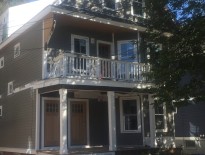Massachusetts has done something remarkable – it has produced more than 1,750 new units of supportive housing in just three years. By doing so, it has helped to stabilize the lives of thousands of formerly homeless families and individuals. And by helping these families become more self-sufficient, neighborhoods and communities across the state have been strengthened.
Why is this so remarkable? Because even though Massachusetts has an affordable housing finance system that can be considered the nation’s gold standard, the commonwealth’s nonprofit affordable housing providers still face considerable challenges in producing new units of housing for extremely low-income residents. Supportive housing, in which organizations offer support services and affordable housing, can be even more complex for agencies to create. So it is encouraging to see that the commonwealth not only met but exceeded its goal in developing new units.
How did Massachusetts do it? For one, the state brought all of the major players together to work collaboratively towards a goal. For the past several years, 20 state agencies, from those focused on housing to those providing human services, have worked together in a collaborative effort to improve the way we fund and produce supportive housing. This interagency initiative, chaired by Health and Human Services Secretary Marylou Sudders and Housing and Economic Development Secretary Jay Ash, meant improved communication and coordination, more sharing of information, and a better understanding of best practices.
For another, the commonwealth also experimented with ways of streamlining an often complicated funding process. Nonprofit organizations require different sources of financing to turn the idea of a project into a reality – they need capital dollars to acquire or build affordable housing, operational funding to maintain units and service funding for tenant stabilization and other supports. Piecing together that kind of financing can be a challenge, especially for smaller nonprofits.
But a successful pilot program that allowed affordable housing developers to access these funding streams in a consolidated process proved to be an effective way of developing supportive housing units. CEDAC, which provides early stage capital to nonprofit affordable housing developers, played a role in both efforts. We helped lead the interagency initiative and worked closely with the Department of Housing and Community Development on the pilot program.
An example of the pilot program’s success can be found in the partnership between Lowell’s Coalition for a Better Acre (CBA) and the Veterans Northeast Outreach Center (VNOC), which teamed up to build 27 units of supportive housing near downtown Haverhill. One of the first projects to benefit from the combined funding process, the Welcome Home Vets project now serves 27 veterans households.
More To Be Done
There is additional good news – the governor’s capital budget includes $1.1 billion for affordable housing production and preservation over the next five years, an 8 percent increase in FY17 and 18 percent increase over the life of the plan, and includes an enhancement of resources for supportive housing. And we will see additional funds from the federal government for production of these units. In April, the U.S. Department of Housing and Urban Development (HUD) announced the launch of the National Housing Trust Fund to help states create new housing for extremely low-income individuals. While the fund is modest in its first year – $174 million to be shared among all 50 states – it will still help Massachusetts in its quest to help homeless families and individuals find housing. And it could grow. The initial allocation for Massachusetts from the fund is $3.4 million.
The proof of all of the commonwealth’s efforts to address homelessness is in the numbers – after many years of hard work by providers and policy makers, the numbers of homeless families living in motels has sharply declined. Producing supportive housing units is one of the ways that the commonwealth has pursued to move homeless families out of emergency shelter.
Massachusetts has shown it is possible to address the challenge of homelessness but there is, of course, more work to be done. We remain a state with a high cost of living and one where income inequality is growing. The successful supportive housing initiative has been merged into the state’s Interagency Council on Housing and Homelessness, demonstrating a continued commitment by the state. With critical agencies working together on a common goal, we can continue to find new ways to strengthen communities and stabilize families.
Roger Herzog is the executive director of the Community Economic Development Assistance Corporation (CEDAC).




 |
| 


